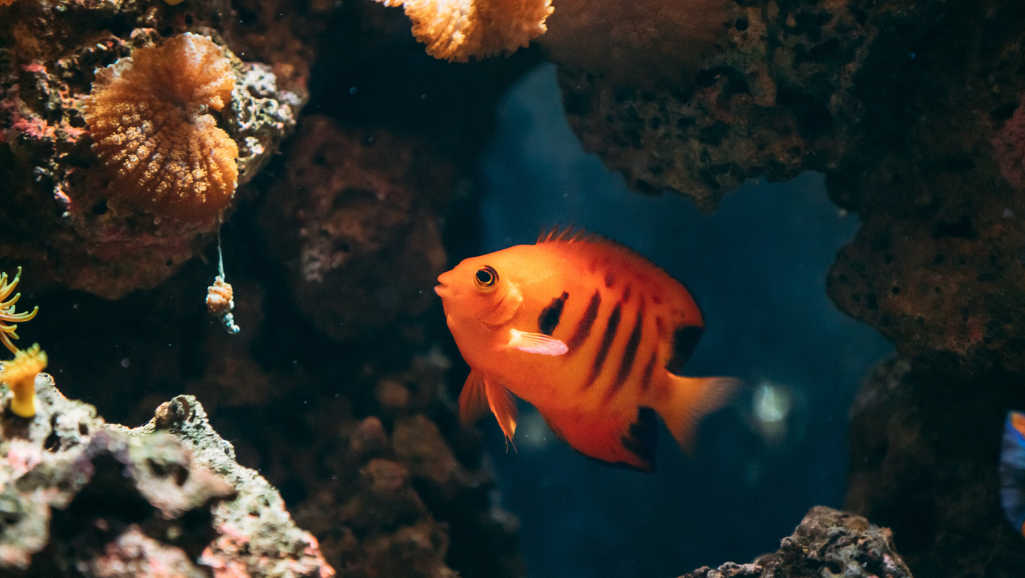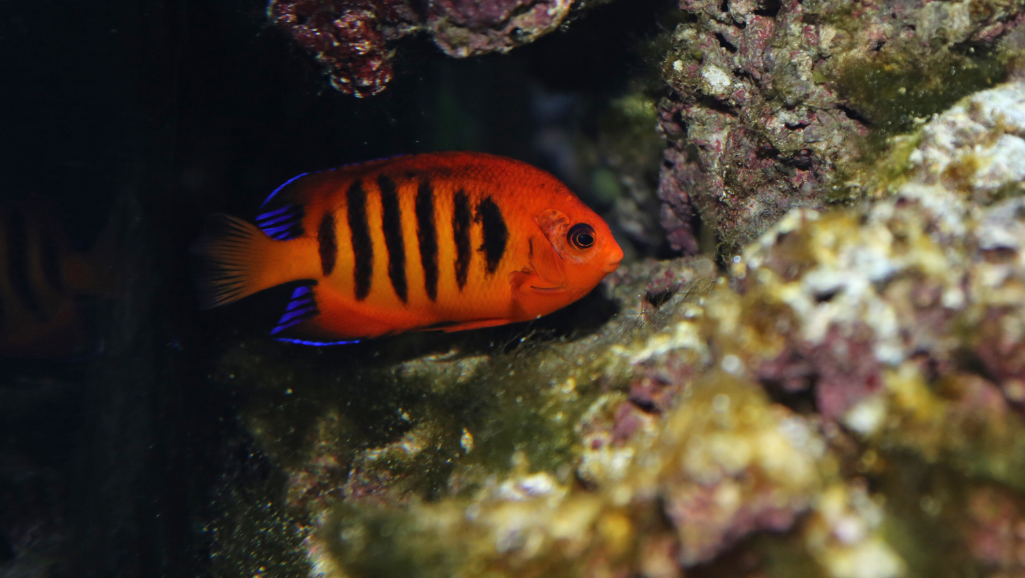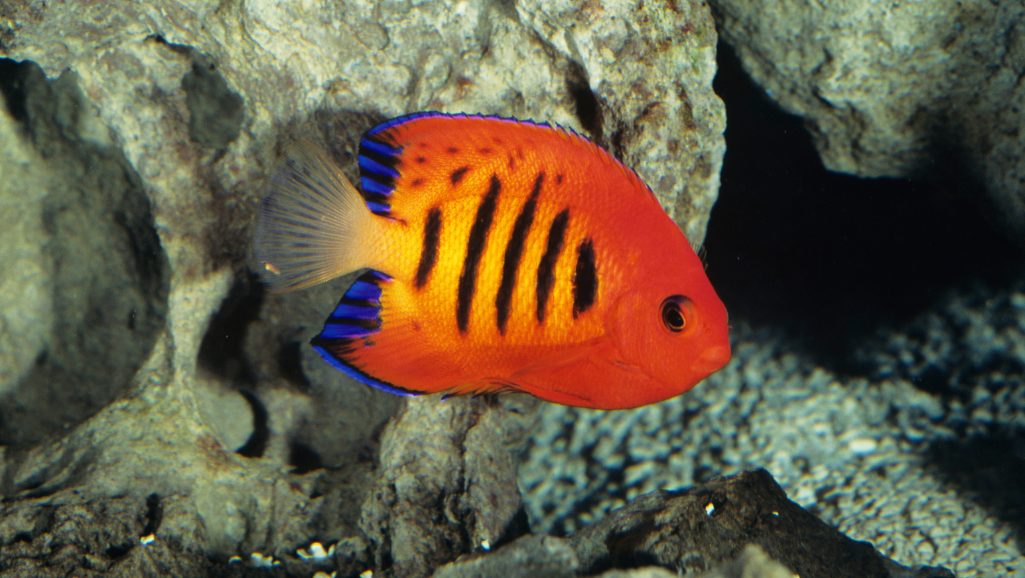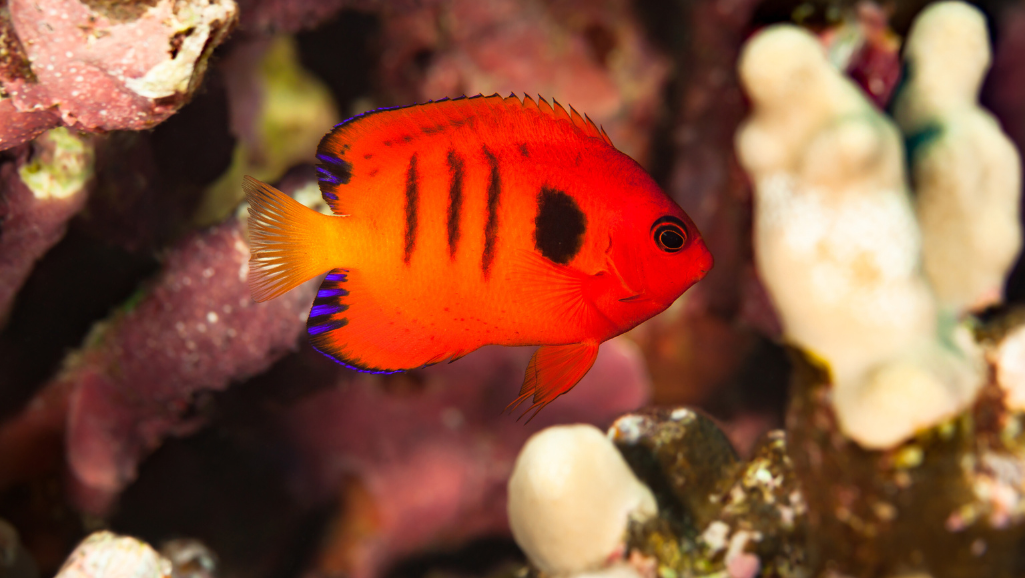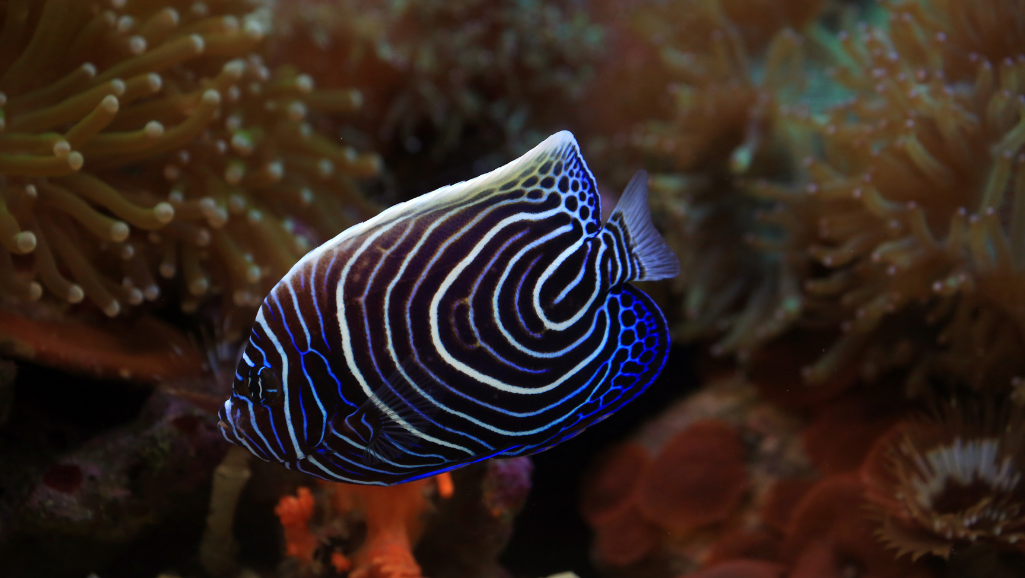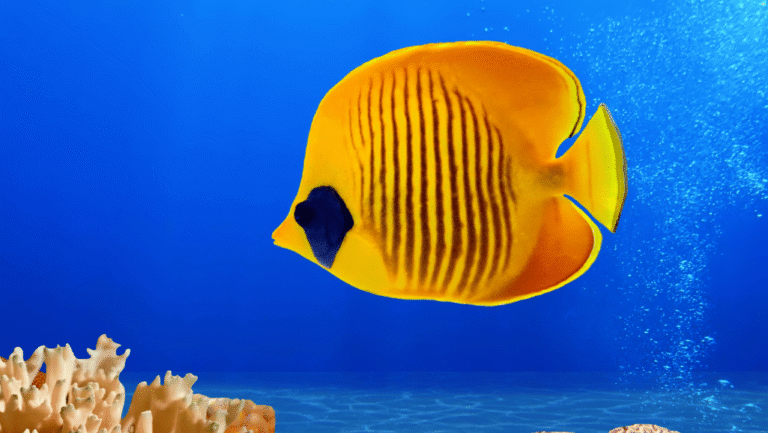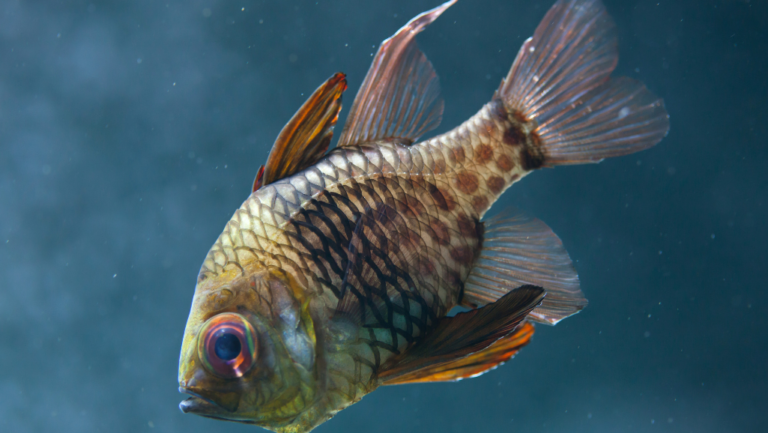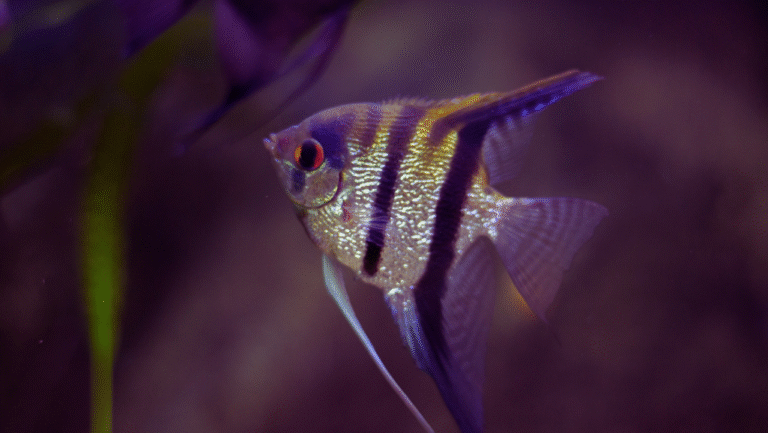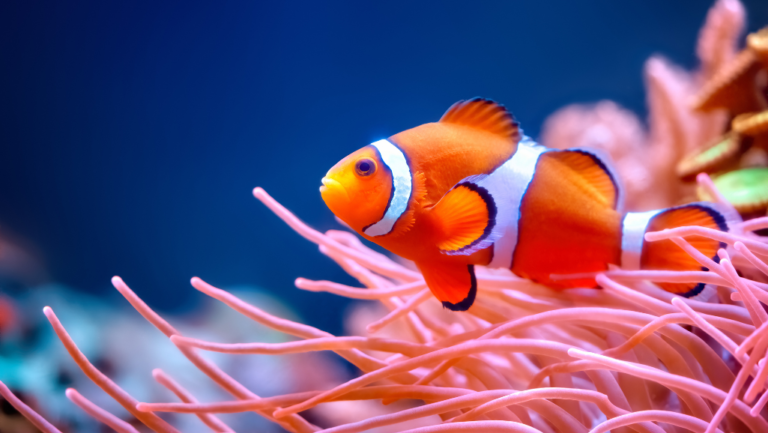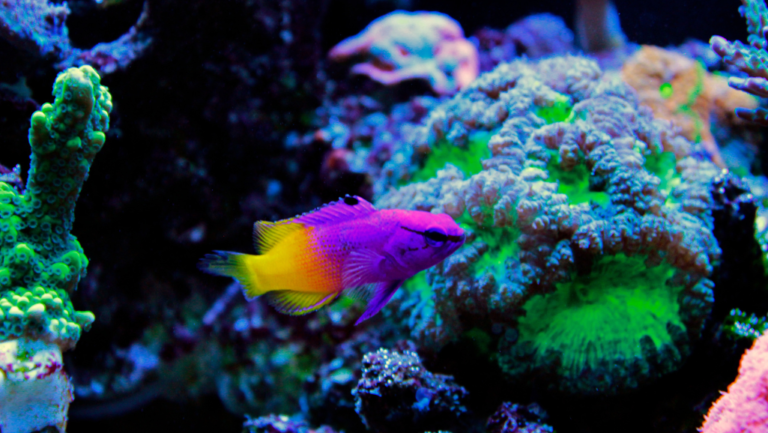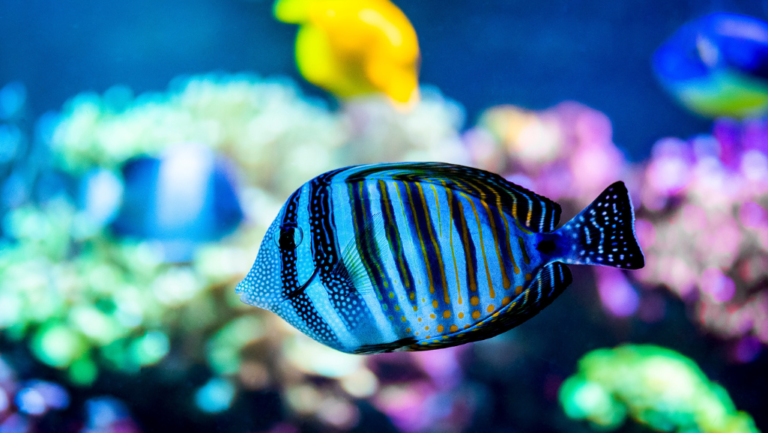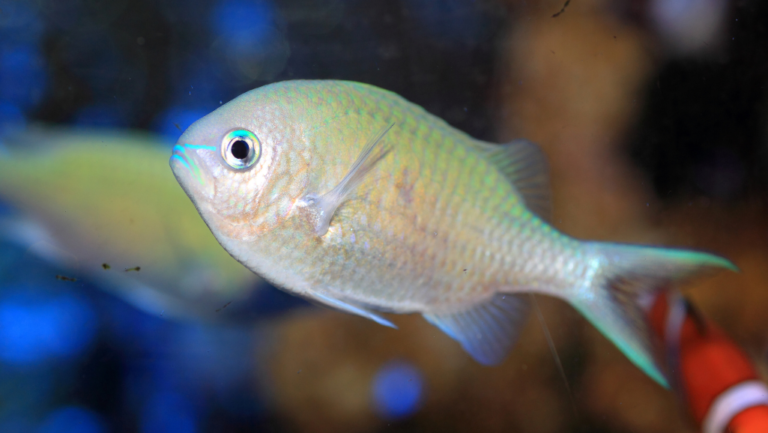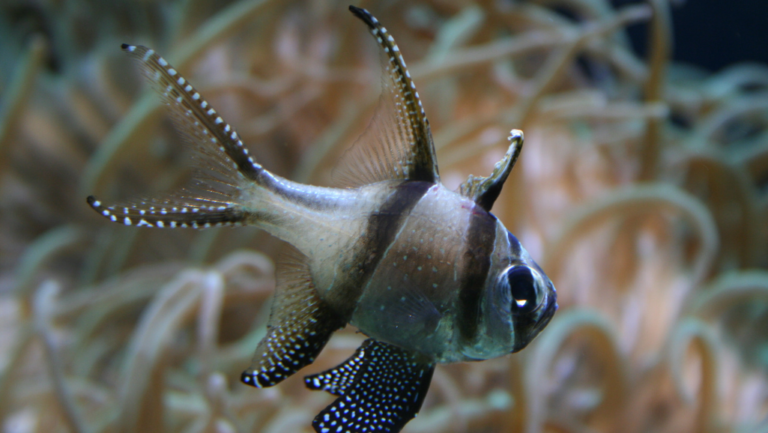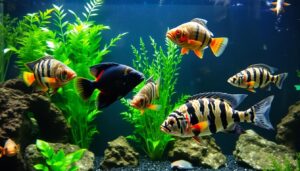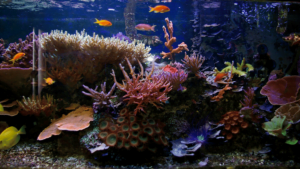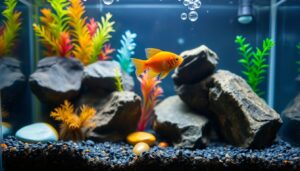Flame Angelfish are marine aquarium fish known for their fiery look and graceful swimming. They come from the reefs of Oceania. To keep them happy in your tank, you need to focus on water quality and a well-set habitat.
This guide will help you understand how to care for Flame Angelfish in your home aquarium. They need a tank that mimics their natural home, which is deep and has lots of coral. They also need a varied diet and a peaceful tank environment.
It’s important to know that Flame Angelfish can live for 5-7 years with the right care. They can grow up to 6 inches long. So, they need a big tank, at least 55 gallons, to swim around comfortably.
Flame Angelfish are sensitive to copper, so you must use copper-free treatments when setting up their tank. They are also semi-aggressive and like to have their own space, which can be a challenge in a tank with other fish.
They eat a variety of foods, like brine shrimp and algae, to stay healthy. But, they might nip at corals, so be careful when adding them to a reef tank.
Key Takeaways
- With proper care, Flame Angelfish can enjoy a lifespan between 5-7 years within a reef tank.
- Reaching sizes up to 6 inches, Flame Angelfish require spacious environments, favoring tank capacities starting from an ideal 55 gallons.
- Flame Angelfish thrive in environments free of high copper concentrations and benefit from quarantine procedures that adhere to this necessity.
- Equipped with a semi-aggressive temperament, these marine beauties assert their space, particularlly among other angelfish.
- Omnivorous by nature, a Flame Angelfish’s diet should include a variety of options like brine shrimp and marine algae to mirror their dietary intake in the wild.
- Althougth generally reef-safe, Flame Angelfish may have a tendency to nip at corals, suggesting a cautious approach when introducing them into reef tanks.
Understanding Flame Angelfish Species and Traits
The Centropyge loriculus, or Flame Angelfish, is a stunning sight in marine aquariums. It brings color and helps with marine biodiversity. Its bright red-orange body with black stripes makes it a hit among colorful angelfish fans.
Exploring their traits and behaviors is key. Knowing their natural habitat and social life helps us care for them better. This ensures a healthy mini-ecosystem in our tanks.
Physical Characteristics
Flame Angelfish grow up to 12 cm, with males reaching 15 cm. Their colors vary by location, showing the beauty of different marine areas.
Natural Habitat
These angelfish live on reefs in Oceania, like the Marshall and Cook Islands. They prefer 22°C to 26°C temperatures and rich coral systems. Here, they eat algae and stay near shelters.
Behavior and Social Structure
Flame Angelfish are semi-aggressive and live in small schools. They graze on the reef’s edge. In tanks, they can be territorial, so choosing tank mates carefully is important.
Knowing their needs and social habits is essential for keeping Centropyge loriculus in aquariums.
These fish adapt well to tanks, thanks to breeding programs like Atoll Farm Aquaculture in Thailand. But, they might damage coral or clams if not fed enough. A balanced diet is key to mimic their natural feeding.
In conclusion, the Flame Angelfish showcases marine beauty and complexity. Their care demands understanding their looks, habits, and ecological needs.
Essential Tank Requirements for Flame Angelfish
To create the perfect home for Flame Angelfish, you need to know and meet certain needs. These saltwater fish love environments that remind them of coral reefs. Setting up your tank is both important and fun.
Minimum Tank Size
A 55-gallon tank is best for one Flame Angelfish. They need space to swim and claim their territory. A bigger tank means better water and a more interesting community of marine aquarium fish.
Water Parameters
Flame Angelfish need clean, stable water to stay healthy. Keep the temperature between 72-78°F, pH at 8.1-8.4, and specific gravity at 1.020-1.025. Regular water changes and good filters are key to keeping these conditions right.
Aquarium Setup
For a natural look, add lots of live rock. It gives them places to hide and eat. Arrange the rocks to make a maze of territories. Also, make sure your tank doesn’t have copper, as these saltwater fish are very sensitive to it.
Designing a tank that meets Flame Angelfish needs is the first step to a thriving aquarium. A well-kept tank is like a mini coral reef, full of life and color.
Proper Diet for Flame Angelfish
To keep your Flame Angelfish looking vibrant and healthy, a balanced diet is key. These fish are omnivores, which means they eat both plants and meat. Here’s how to feed them right.
Types of Food
In the wild, Flame Angelfish eat marine algae and small invertebrates. In your tank, give them high-quality angelfish food. Add mysis shrimp, brine shrimp, and spirulina for extra nutrition. Nori and marine algae pellets are also great for them.
For more tips on feeding your Flame Angelfish, check out Reef Chasers.
Feeding Frequency
Flame Angelfish do best with small, frequent meals. Aim for two to three meals a day. This helps them digest better and keeps your tank clean.
Nutritional Needs
Flame Angelfish need a varied diet to stay healthy and colorful. Include marine algae and mysis shrimp for proteins and omega-3s. Make sure their food is full of vitamins and minerals too.
For more care tips and dietary advice, visit Aqua Joy Life.
By following these tips, your Flame Angelfish will thrive in your aquarium.
Tank Mates Compatible with Flame Angelfish
Choosing the right tank mates for Flame Angelfish is key to a peaceful coral reef tank. Flame Angelfish are semi-aggressive. So, it’s important to pick fish that match their behavior, size, and diet.
Best Companions
- Clownfish: Clownfish are hardy and peaceful. They won’t challenge Flame Angelfish for space.
- Royal Gramma: This fish is colorful and calm. It avoids fights and adds beauty to your tank.
- Cardinalfish: Cardinalfish are active at night. They keep to themselves during the day, making them good tank mates.
Fish to Avoid
- Other Angelfish: Having multiple angelfish can cause fights. They compete for food and space.
- Damsels: Damsels are territorial and can be aggressive. They’re not good for small tanks.
- Large Predatory Fish: Big fish might bully smaller fish like Flame Angelfish. This can harm them.
Considerations for Community Tanks
Building a community reef tank needs careful planning. Here are some tips to keep your fish happy:
- Space: Flame Angelfish need room to swim and behave naturally. Avoid overcrowding to prevent stress and fights.
- Dietary Match: Make sure all fish get the food they need. Flame Angelfish are omnivores and need a varied diet without competition.
- Environmental Enrichment: Add rocks and hiding spots. This helps fish claim territory and find refuge, reducing fights.
By following these tips, you can create a lively and diverse aquarium. It will be a great home for your Flame Angelfish and other fish.
Breeding Flame Angelfish in Captivity
Starting to breed flame angelfish is both thrilling and challenging. These colorful fish are a sight to behold and show off advanced marine aquarium fish breeding skills.
Breeding Requirements
To breed flame angelfish, you need a special breeding tank. It should look like their natural home to help them spawn. Keep the tank’s temperature between 72-78°F and the pH levels between 8.1-8.4.
Also, the salinity must be between 1.020-1.025. This is key for their breeding cycle. Starting with young, aquacultured angelfish is helpful. They are healthier and already eat pellets, making feeding easier.
Care of Offspring
After they spawn, the larvae need careful care. They must have clean, stable water and the right food to survive. Breeders must watch their health and diet every day.
Buying your breeding stock from Biota Hawaii is a good idea. It ensures your fish come from a reputable source. This boosts your chances of successful breeding and supports sustainable aquarium trade.
Common Challenges
One big challenge in breeding flame angelfish is finding compatible pairs. Fry mortality is also high. Breeders must try different pairs and settings to succeed.
Flame angelfish are known for being friendly to humans. This makes them easier to breed, as they’re less stressed by human presence. This is important for their health.
Syd Kraul, a well-known fish breeder, says breeding these fish meets demand and helps species diversity. As aquaculture grows, these fish will be more available and affordable.
Learning about marine aquarium fish breeding helps aquarists enjoy Flame Angelfish. It also helps preserve and spread these fish in home aquariums. Using aquacultured fish is a sustainable way to keep aquariums.
Health Issues and Care for Flame Angelfish
Keeping Flame Angelfish healthy is key. These colorful fish can live five to seven years. They cost between $75 to $200 and grow up to six inches long. They are delicate and can get sick easily.
Identifying Common Diseases
Watch for marine ich, a common disease in saltwater fish. Look for white spots, trouble breathing, and being very tired. Keeping the water right, between 72 to 78 degrees Fahrenheit and pH 8.1 to 8.4, helps prevent sickness.
Preventative Measures
Good water quality and a balanced diet are essential. A 45 to 70 gallon tank is best for them. This size helps avoid fights and stress. Watching your fish and tank closely can stop diseases before they start.
Treatment Options
When sickness happens, choose safe treatments for Flame Angelfish. Avoid copper treatments because they harm fish. Instead, use safer options. Learning from caring for other sensitive fish, like Galaxy Rasboras, helps keep Flame Angelfish healthy. For more on caring for delicate fish, visit this link.
